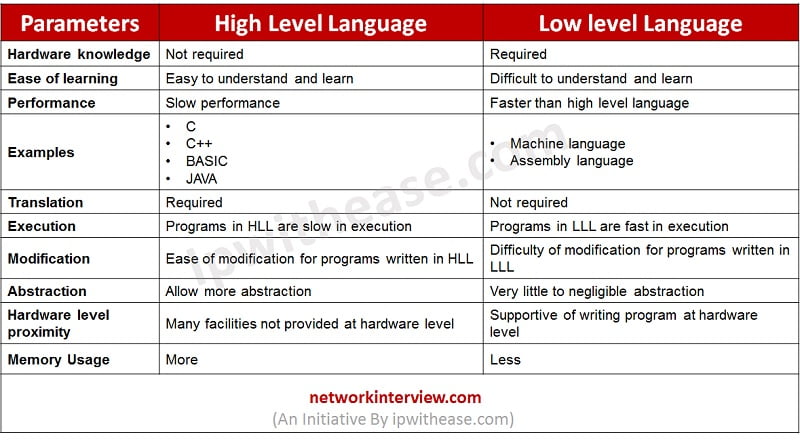Explain the Difference Between High Level Languages and Machine Language
High-level language is a computer language which can be understood by the users. In this era high-level language is widely used by programmers because of their ease of code and thats easy to understand.
What Is The Difference Between Machine Code And Assembly Language Pediaa Com
An interpreter implements a virtual machine whose machine language is the high-level programming language.

. Such languages are considered high-level because they are closer to human languages and further from machine languages. The high-level languages are considered as high-level because they are closer to human languages than machine-level languages. High-level programming languages are easier for humans to understand.
A compiler is required to translate a high-level language into a low-level language. This is because high-level languages have a lot of abstractions and layers of code before they reach the hardware itself whereas since machine code is nearer its actually fast to process and return the output. When writing a program in a high-level language then the whole attention needs to be paid to the logic of the problem.
A High Level Language requires a compiler or an interpreter to convert the program into machine code. Programs written in the machine language of a given type of computer can be directly executed by the CPU of that type of computer. Using this language it is possible to communicate with computers directly.
A program instruction in machine language may look something like this 111010110010001 whereas a high-level language is a programming language that use. It is a machine independent language. Answer 1 of 16.
High level Language. 9 rows High Level Language Low Level Language. The machine language is system independent because there are different set of binary instruction for.
Compiler translates high level source program into a equivalent target program machine language. Machine language is first generation and low-level programming language. MACHINE LANGUAGE - the language of 0s and 1s is called as machine language.
High level languages are written in a form that is close to our human language enabling to programmer to just focus on the problem being solved. Explain the difference between high-level languages and machine language. A high-level language HLL is a programming language such as C FORTRAN or Pascal that enables a programmer to write programs that are more or less independent of a particular type of computer.
Programming languages are classified as. The interpreter reads statements in that language more or less one at a time executing them as it goes along. 3 High level language.
Language recognized by a computer is known as machine language. These programmer friendly languages are called high level as they are. 17 rows We perform the conversion of a high-level language into an assembly language and then into a.
Assembly Language requires an assembler to convert the program to machine code while machine language is executed by the computer directly. 17 rows The primary difference between low and high-level languages is that any programmer can. The high-level language is very similar to human languages and has a set of grammar rules that are used to make instructions more easily.
It enables a user to write programs in a language which resembles English words and familiar mathematical symbols. To understand the difference between compiling and interpreting lets examine the equivalent in human languages. It is a.
This language is called low-level language because it is directly related to hardware. A machine language is the only language that a computer directly understands it is usually written in zeros 0 and ones 1. Each statement in a high level language is a micro instruction which is translated into several machine language instructions.
High-level languages are usually slow when compared to low-level languages. Machine language is the only language a computer is capable of understanding. The key difference between machine language and assembly language is that machine language executes directly by a.
Assembly language is the more than low level and less than high-level language so it is. A High Level Language is easily understandable by the programmer. The difference is machine language executed directly by CPU whereas machine language is first converted to binary by the compiler and then executed by CPU.
It is less memory efficient ie it consumes more memory in comparison to low-level languages. Difference Between MachineAssembly and High Level language. Every high-level language has a set of predefined words known as Keywords and a set of rules known as Syntax to create instructions.
It is programmer friendly language. Machine language and assembly. No particular knowledge of the hardware is needed as high level languages create programs that are portable and not tied to a particular computer or microchip.
There are two categories of low-level languages. Assembly language is the language between high-level languages and machine language. COBOL was the first high level language developed for business.
High Level Language require a Compiler to convert into ASSEMBLY THEN machine level codeNow-a-days compilers are smart enough to generate the machine code directly.

High Level Languages Vs Low Level Languages Infographics Educba


No comments for "Explain the Difference Between High Level Languages and Machine Language"
Post a Comment